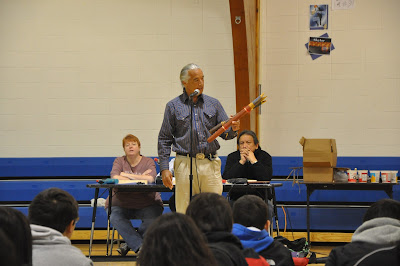Fragrant Water Lilly in bloom, S.D., photo by National Park Service.
The Council
Of The Flowers
Lowliest Flower Becomes Loveliest
As told by Mrs. Kick The Corn, 1915. (Note: Text has undergone some minor editing such as traditional Lakȟkóta names for the flowers.)
FORT YATES, N.D. - A long
time ago all the Wanáȟča (Flowers)
lived anywhere they happened to be. The Uŋžíŋžiŋtka (Prairie Rose), the Čhuŋwíyapehe
Iyúwi (Wild Grape), the Waȟčázi (Sunflower),
the Waȟpé Tȟó (Violet) and all the
rest, lived side by side. They could not keep their families
together. They were not pleased about this, so it was decided to hold a
great council of the Wanáȟča Oyáte (Flower Nation) and divide the
land among them, so that each could have their own places to live in.
So they all gathered together
in one place and each made a speech and ate of the feast which was prepared. After
several days of speech-making and celebration, it was decided the Uŋžíŋžiŋtka should grow on the prairie
in the sunshine; the Čhuŋwíyapehe Iyúwi
should live among the trees in the shade; the Waȟpé Tȟó should grow in the shade of the cool, moist forest
places; the Waȟčázi should grow along
the hot, dusty trail and all the other Wanáȟča
and Čháŋ (Trees) should have his own
place.
Then the council broke up
and everybody started home. But a poor, ill-favored Wanáȟča came limping into camp just as the Wanáȟča Oyáte were going
away. It was tired, hungry and almost dead. It had had so far to
come to the council that it had not arrived in time to present its claim to any
ground to live in.
They decided to hold another
council just for this poor Wanáȟča. But
there was no other place for it to have, as all the ground was gone. But Iŋktómi (Spider) spoke with wisdom and
said that there was some ground which had not been taken. This should be
the poor Wanáȟča’s home, and on
account of it having come so far and being so tired, he would call upon the Iŋktómi Oyáte to make it the most lovely
Wanáȟča on Makȟóče’s (Grandmother’s) blanket.
So everyone was satisfied
and the council broke up again and the Wanáȟča
Oyáte went to their new homes. The
Waȟpé Tȟó went into the cool, shady
places; the Waȟčázi joyfully went to
the dusty trails; the Čhuŋwíyapehe Iyúwi
started to climb the great trees; the Uŋžíŋžiŋtka
found a warm spot under the sun out on the prairie; and all the rest found
their new places.
The ill-favored, stinking,
little Wanáȟča which had come last to
the council, then went to its new home in the ground beneath the waters of the
ponds and slowly-moving waters of the small creeks, and grew to be the most
beautiful of all flowers and, with the most pleasing breathe.
It is now called Mniȟčáȟča (Water Lily).
Wanáȟča: Flower
Uŋžíŋžiŋtka:
Prairie Rose
Čhuŋwíyapehe Iyúwi: Wild Grape
Waȟčázi:
Sunflower
Waȟpé Tȟó:
Violet
Oyáte:
People or Nation
Čháŋ: Tree
Iŋktómi:
Spider or Trickster
Makȟóče:
Grandmother Earth
Mniȟčáȟča:
Water Lily

.jpg)



